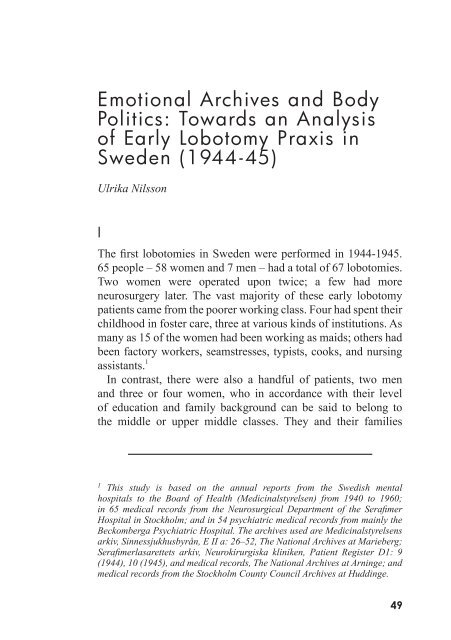Thinking with Bevereley Skeggs - Stockholms universitet
Thinking with Bevereley Skeggs - Stockholms universitet
Thinking with Bevereley Skeggs - Stockholms universitet
- No tags were found...
You also want an ePaper? Increase the reach of your titles
YUMPU automatically turns print PDFs into web optimized ePapers that Google loves.
Emotional Archives and BodyPolitics: Towards an Analysisof Early Lobotomy Praxis inSweden (1944-45)Ulrika NilssonIThe first lobotomies in Sweden were performed in 1944-1945.65 people – 58 women and 7 men – had a total of 67 lobotomies.Two women were operated upon twice; a few had moreneurosurgery later. The vast majority of these early lobotomypatients came from the poorer working class. Four had spent theirchildhood in foster care, three at various kinds of institutions. Asmany as 15 of the women had been working as maids; others hadbeen factory workers, seamstresses, typists, cooks, and nursingassistants. 1In contrast, there were also a handful of patients, two menand three or four women, who in accordance <strong>with</strong> their levelof education and family background can be said to belong tothe middle or upper middle classes. They and their families1This study is based on the annual reports from the Swedish mentalhospitals to the Board of Health (Medicinalstyrelsen) from 1940 to 1960;in 65 medical records from the Neurosurgical Department of the SerafimerHospital in Stockholm; and in 54 psychiatric medical records from mainly theBeckomberga Psychiatric Hospital. The archives used are Medicinalstyrelsensarkiv, Sinnessjukhusbyrån, E II a: 26–52, The National Archives at Marieberg;Serafimerlasarettets arkiv, Neurokirurgiska kliniken, Patient Register D1: 9(1944), 10 (1945), and medical records, The National Archives at Arninge; andmedical records from the Stockholm County Council Archives at Huddinge.49
















